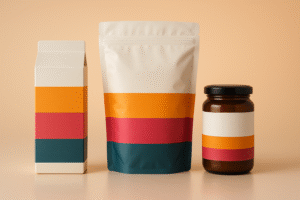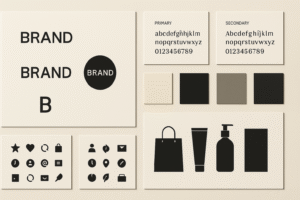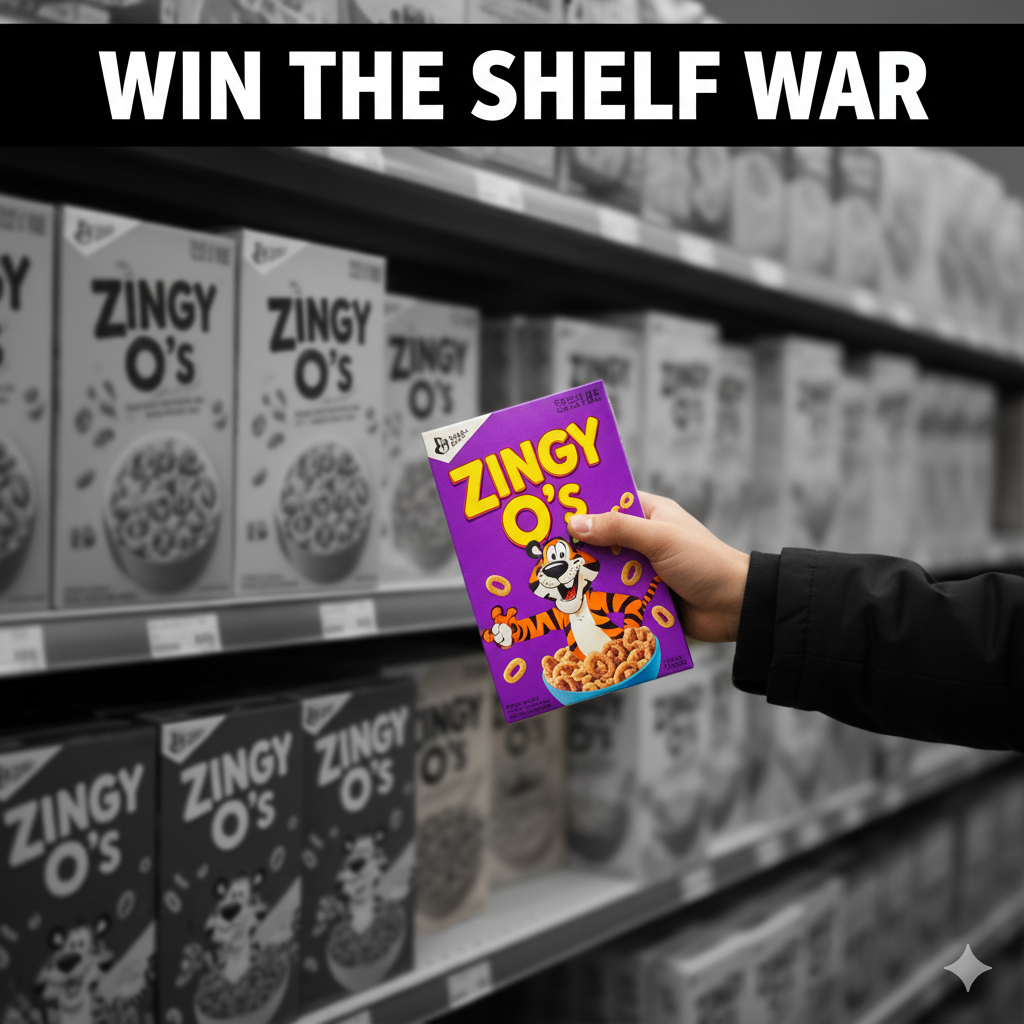Brand Packaging Design: Build a System Customers Recognize, Trust, and Buy
Brand packaging design isn’t just a pretty label—it’s the living system where your strategy, structure, and storytelling come together to protect the product, persuade the buyer, and scale across SKUs, seasons, and stores (physical + digital). This long-form guide shows how to align brand → pack → prepress so your launch looks premium and performs—on shelf and on a 6-inch screen.
Table of Contents
-
Why Brand Packaging Design Matters
-
Brand Strategy First (Promise → Proof → Personality)
-
Structure Before Surface (Dielines, Materials, Barriers)
-
Visual System (Type, Color, Imagery, Icons, Grid)
-
Information Architecture (Front/Back that Actually Sells)
-
E-commerce Readiness (Thumbnails to Unboxing)
-
Retail Execution (Shelf Impact & Planograms)
-
Sustainability Without Green-washing
-
Process That Ships (Step-by-Step)
-
Common Mistakes & Fast Fixes
-
Image Prompts (Hero, System, Before/After, Dieline)
-
FAQs
-
Rank Math Data (Copy-Paste)
1) Why Brand Packaging Design Matters
-
Recognition: Colors, shapes, and typography become memory triggers.
-
Trust: Clear claims + compliance = fewer doubts, fewer returns.
-
Conversion: A legible, benefit-first front panel boosts CTR online and “grab rate” in aisle.
-
Scale: A systemized pack extends to new flavors/sizes without redesign chaos.
Food example with strong structure + color logic: Sushi Packaging Design →
2) Brand Strategy First (Promise → Proof → Personality)
-
Positioning: Premium, clinical, playful, clean, performance? Pick one and commit.
-
Primary Promise: Short, repeatable headline the buyer can quote back.
-
Proofs (2–3): Verifiable claims (e.g., “No Added Sugar,” “Halal,” “Dermatologist Tested”).
-
Voice & Personality: Minimal luxury vs. bold fun; define sentence length, humor, and emoji/illustration rules.
-
Recognition Assets: Wordmark/monogram, secondary mark, color swatches, icon set, photo/3D style.
Deliverable: A concise Brand System Guide the whole team (and printers) can use.
3) Structure Before Surface (Dielines, Materials, Barriers)
Design the object before the art.
Formats
-
Pouches / flow wraps: High billboard, low freight; add hang holes for pegs.
-
Cartons / sleeves: Story space + tamper integrity; pair with inner trays/liners.
-
Jars / tins / tubes: Premium cues, stackability; watch weight/breakage.
-
Multipacks / bundles: Outer impact + inner convenience (easy-open cues).
Materials & Barriers
-
Paperboard/Kraft (add grease liners if oily).
-
Laminates (OPP/PET/PE) tuned for OTR/WVTR (oxygen/moisture).
-
Glass/Metal for maximum barrier; adjust freight expectations.
-
MAP/Vacuum for perishables; design headspace visuals.
Closures & Seals
Zippers, tear notches, tamper bands—engineer the first-open moment into the experience.
4) Visual System (Type, Color, Imagery, Icons, Grid)
Turn strategy into a 5-second read that wins at thumbnail size.
Front-panel hierarchy:
-
Brand mark
-
Product/Variant (largest text)
-
Primary promise (benefit)
-
2–3 proof icons (non-GMO, halal, vegan, etc.)
-
Net weight
Type pairing: One hero display face + one workhorse text family.
Color logic: Assign functional variant colors (Chili=red, Mint=teal, Calm=lavender) and lock them across packs, PDPs, and ads.
Imagery: Appetite macros for food; photoreal 3D renders for supplements/cosmetics to unify the line.
Iconography: 6–12 icons with size rules; don’t improvise per SKU.
Grid: Modular layouts so extensions don’t break the system.
Supplement examples with benefit-first hierarchy:
Dog Supplement Label Design →
More supplement work: Supplement Label Design Freelancer →
5) Information Architecture (Front/Back that Actually Sells)
-
Front: brand → variant → benefit → proof icons → net weight.
-
Side/Back: story, ingredients, nutrition/INCI, allergens, usage, storage, certs, barcode, batch/lot.
-
Localization: dedicated translation panel or QR; never micro-cram the front.
Keep a locked Compliance Layer aligned to the dieline—no accidental nudges.
6) E-commerce Readiness (Thumbnails to Unboxing)
-
Front panel = poster. Big variant + bold color band improves scroll-stop and CTR.
-
PDP gallery: front hero, angled back (compliance), lifestyle, in-hand scale, short unboxing GIF.
-
Copy snippets: three proof bullets in the first image pane.
-
Consistency: same angle/lighting across SKUs → higher trust and repeat buys.
High-contrast variants for attention:
Vape Packaging Design Store →
7) Retail Execution (Shelf Impact & Planograms)
-
Design to the planogram: facings, peg vs. shelf, eye-level vs. lower cabinets.
-
Test at 1–2 meters and at 120×120 px; if it reads there, it reads anywhere.
-
Include spine/side cues for narrow facings (color chips, variant initials).
8) Sustainability Without Green-washing
-
Right-size the pack; reduce void and plate count.
-
Prefer mono-materials where possible for simpler recycling streams.
-
Be specific about end-of-life (“recycle where facilities exist”); avoid vague claims.
-
Test finishes on actual stock; some foils/laminates affect recyclability.
9) Process That Ships (Step-by-Step)
-
Brief & moodboard (category codes, tone, claims).
-
Structure & dieline lock (printer stock + barrier data sheets).
-
Concept territories (2–3) stress-tested at thumbnail size.
-
Refinement + compliance (nutrition/INCI, allergens, certs, barcodes, translations).
-
Prepress (CMYK/spot strategy, trapping, overprint, barcode scale).
-
Press/first article check (adjust to real ink/stock).
-
Launch assets (3D renders, lifestyle frames, PDP kit, unboxing GIF).
10) Common Mistakes & Fast Fixes
-
Everything screams on front. → Enforce hierarchy; move story to side/back.
-
Variant chaos. → Lock color bands, icon grid, and naming logic.
-
Barcode failures. → 100% black on white, quiet zone intact, test at print scale.
-
Grease bleed on kraft. → Specify grease-resistant liners or change stock.
-
Thumbnail mush. → Larger variant, fewer words, higher contrast.
12) FAQs
Q1. What’s the difference between packaging design and brand packaging design?
Packaging design focuses on the pack; brand packaging design integrates brand strategy (promise, voice, recognition) into every structural and visual decision.Q2. Which comes first—brand or pack?
Build a light brand system (logo/type/colors/voice) first, then lock structure and design the pack. For speed, run in parallel with clear roles.Q3. How big should the variant name be?
Usually the largest text after the brand; must read at 120×120 px.Q4. Digital vs. flexo vs. gravure printing?
Digital for pilots/short runs; flexo for efficient scale; gravure for very high volumes and tight color.Q5. Should certifications be on front?
Only if earned and relevant to buyers; misuse damages trust.Q6. What files will my printer need?
Press-ready PDFs on final dielines (1:1), outlined fonts, embedded images, CMYK/spot profiles, correct barcode size, locked compliance panels.Q7. Can you help with e-commerce imagery?
Yes—consistent 3D renders/angles, back-of-pack, lifestyle, in-hand scale, and an unboxing GIF.
Hire Us to Align Brand + Pack (and Ship)
Need brand packaging design that looks premium and performs—on shelf and online? Let’s build it.
-
Food example: Sushi Packaging Design
-
Supplements: Dog Supplement Label Design
-
High-impact variants: Vape Packaging Design Store
-







